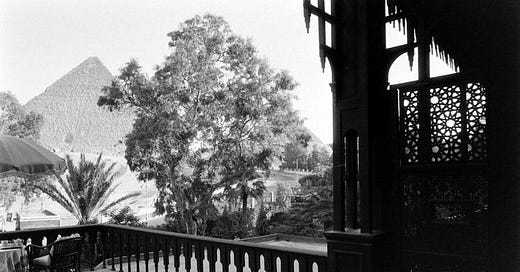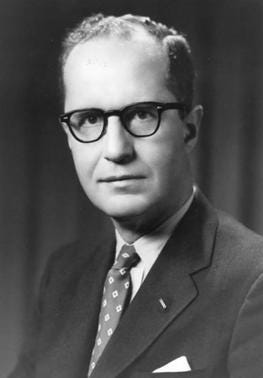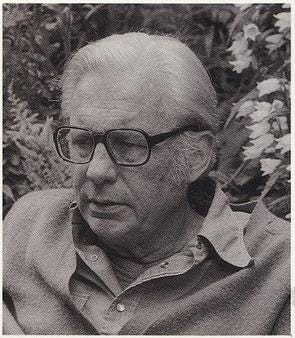Lunch at Mena House
In October 1952, against the background of the pyramids, at the Mena House in Cairo, Egypt, Kermit “Kim” Roosevelt, grandson of former President Theodore Roosevelt and distant cousin of Franklin, met with a handsome, articulate and charismatic Egyptian officer, a leader of the “Free Officers” movement in Egypt and deputy Prime Minister, Gamal Abdel Nasser. Nasser, as leader of the Free Officers in Egypt, was a staunch Egyptian nationalist, anti-imperialist, and believer in Pan-Arab Socialism, which was less economic and more about consolidating all Arabs into a combined voice from “Morocco to Oman.”
Just three months prior, Colonel Nasser, along with the official leader of the Free Officers, General Muhammed Naguib, had just led the Free Officers in the successful 23 July Revolution which ousted King Farouk from power and replaced him with puppet Monarchy under his infant son, King Fuad II. On 26 July, King Farouk, along with King Fuad II and their family, set sail from Egypt destined for a life in exile. On 28 July, Naguib was made the first President of Egypt. A few months later, in a consolidation of power, the Revolution Command Council, chaired by Naguib, outlawed all political parties for 3 years and set a new secular (rather than Isalmist) constitution.
Viewed by many as a pawn of the Soviet Union, Nasser gave an outward appearance of non-alignment towards either major power, but as it has been discovered, maintained a secretive relationship with the CIA & Kim Roosevelt, at least, until it was no longer useful for him.
Kim Roosevelt, American Royalty & Coup Master
Kermit “Kim” Roosevelt, born on February 16, 1916 in Buenos Aires, Brazil to Kermit & Mary Roosevelt, was raised as child of adventure with his dad and his grandfather. He grew up near the family homestead of Sagamore Hill in Long Island, NY, and graduated Harvard University in 1937. A brilliant man, he taught history at Caltech until the start of World War II. During WWII, Kim joined the Office of Strategic Service (OSS) and served as it’s main historian post-war. During his time in the war, his father, Kermit, committed suicide while stationed in Alaska after a life long battle with depression. Roosevelt in the post-war years developed a working relationship with the American Arab community and worked extensively in the Middle East for pro-Arabist causes. In 1950, Kim accepted a position at the CIA in their Office of Policy Coordination, and took an assignment to Egypt. While in Egypt, Kim orchestrated along with CIA Director Allen Dulles, Secretary of State Dean Acheson, and CIA Station Chief Miles Copeland Jr. a plan to establish a more progressive and American friendly monarchy in Egypt that would be a bastion against Communism in the Middle East.
Project FF
Project FF, as it was nicknamed from the more crude ‘Fat F*cker,’ was the starting point for American work in Cairo. Initially aimed at rooting out corruption in the existing government by encouraging King Farouk to pass reforms, it later changed to overthrowing Farouk as he was unwilling or unable to make, what the US saw, as needed changes in his government. These reforms aimed at lessening the influence of Soviet-style communism in the Middle East by propping up existing, conservative governments like Egypt, Jordan, Saudi Arabia, and Iran. With the non-compliance of King Farouk, Kim Roosevelt sought out the more organized opposition and began meeting with the Free Officers, a group of military officers already planning a coup d'état to overthrow the Monarchy and establish a republican form of governance. From the CIA, Kim offered both intelligence and support for the coup and the soon to be newly formed government. Which brings us back to the meeting with Nasser at the Mena House in Cairo, Egypt in October 1952.
“Roosevelt’s Erection”
Roosevelt’s meeting with Nasser was an attempt to build a working relationship between the United States and the burgeoning Arab republic. Following World War II, the United States had begun to replace Great Britain and France as the key players in the region as both were simultaneously embarking on decolonization efforts starting in the mid-to-late 1950s. In her article, “Egypt’s Giant Middle Finger to America,” Farah Halime recounts the story of Roosevelt meeting with Nasser discuss replacing “France and Britain as Egypt’s banker and weapons supplier in exchange for political stability and guarantees that Nasser wouldn’t support Algeria’s uprising, work with the Soviets or oppose Israel.” Nasser, himself still a young man in his early 30s, was incensed at the thought he could be bought, but still rose up and shook Roosevelt’s hand, allegedly remarking, that “someday there will be a monument built to him.” Allegedly, Kermit gave a briefcase of money (between $1M and $6M) to an associate of Nasser for “presidential security accruements.”
As the head of covert operations in the Middle East, in 1953, Roosevelt spearheaded the CIA-led effort to overthrew the democratically elected government of Iran and install an American-friendly leader in the Shah. This led to further disagreement with Nasser. In 1954, Egypt began the building of a giant “phallic-like” monument in the center of Cairo. This monument was allegedly paid for by the funds provided by Kermit to Nasser just a year or two earlier. This monument was, and is still, known as “Roosevelt’s Erection.”
This also coincided with the deterioration of US-Egypt relations and the increasing influence of the USSR in the Arab-led Middle East and North Africa. With no support of Israel coming from Nasser, the United States refused to fund a 200-million dollar dam project and to also sell weapons to Egypt and Syria. This led Nasser to obtain weapons for Egypt from the Soviet Union. While Nasser was not a communist, and actively sought to disrupt communist activity, he did find himself surrounded by many advisors who were pushing a greater Soviet-Egypt partnership.
Later Life and Retirement
In 1954, President Eisenhower awarded Kermit the National Security Medal in a secret ceremony. In 1957, Roosevelt planned, but did not execute, leaving that to another agent, a coup in Syria to establish another pro-western government. After it’s failure, and with a growing trend towards disengagement in the Middle East, Roosevelt left the CIA in 1958 and began to work for private defense and oil companies. He maintained relationships with many agents and colleagues in the Middle East, and especially kept a very friendly relationship with the Shah of Iran.
Roosevelt lived a relatively quiet life, post-CIA, and in 2000, passed away at the age of 84. As the US involvement in the 1953 Iranian Coup was declassified, and the full involvement of Roosevelt in its planning and execution was made public, Kim “Kermit” Roosevelt made a short yet astute assessment of his own life:
I have had a satisfactory, often exciting life, of which I am appropriately proud.
He was survived by his wife of 64 years, Mary Lowe, and had four children and seven grandchildren at the time of his death.
Legacy
With the fall of Iran in 1979 to Islamic radicals, the 1953 Coup planned and put into action by Kermit has been viewed with 20/20 vision. It is seen now as pushing back the progress of Iran and most likely, contributing to the rise of Ayatollah Khomeini and his brutal rule.
In Egypt, Nasser ruled as President or Prime Minister until 1970, when he passed away from a heart attack while attending the Arab League summit. During his tenure as Egyptian leader, he lost to Israel in the Six Day War in 1967 and saw the loss of the Sinai Peninsula in that same war. After his death, he was succeeded by Anwar Sadat as President of Egypt. Sadat fought Israel in the Yom Kippur War and eventually negotiated with Israel to sign the Camp David Accords peace treaty under then-President Jimmy Carter in 1979. In 1980, Sadat was assassinated by members of the Islamic Jihad and was replaced by Hossni Mubarak who served as head of state until 2011 when he was overthrown in the Arab Spring revolutions. Egypt has once again, at this time, returned to a military rule similar to the 1952 revolution.
Overall, the United State’s legacy in the Middle East, and not just Roosevelt’s alone, is one that became much more adversarial as time went on and the United State’s solidified its almost unconditional support for the nation of Israel. With light shown on the US covert involvement and coupled with the US Invasions of Iraq in 1991 and 2003, US standing in the MENA is dismal. Our big question remains:
How do we support republics in the MENA?








